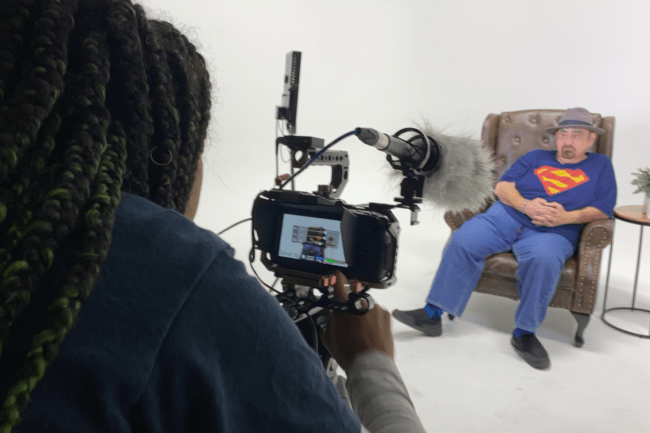The power of storytelling in marketing: How to reach your audience
Storytelling in marketing is an effective way to connect with potential customers and build strong relationships with them. It allows you to engage people on a deeper level by creating a lasting impression in their minds.
Stories are memorable, shareable, and timeless – essential for successful marketing campaigns.
A common marketing mistake is focusing solely on a product or service instead of the people that use it. People unfamiliar with your brand don’t care about features; they care about benefits and how it solves their problems.
You must learn to tell personal and relevant stories to stand out from the competition. Through storytelling, you can create an emotional connection with your audience, helping them to relate to and remember your brand.
Here are strategies for Crafting an Effective Storytelling Campaign:
• Know your audience
• Focus on the message
• Choose the right format
• Capture attention quickly
• Keep it concise and simple
• Benefits over features
• Include visuals/images where appropriate
• Create a narrative arc
• Include a call to action
Know your audience
The first step to telling a compelling story is knowing who you’re telling it to. You need to understand the values and beliefs of your audience so that you can craft stories that make sense to them.
Consider their age, location, interests, and other data points that will help you hone in on the right message and create relatable stories.
The main character(s) in your story should also align with your target audience. If you’re targeting a younger demographic, create a cast of characters they can relate to and understand.
Be authentic and ensure your story reflects real-world experiences your audience can relate to.
Focus on the message
Once you have your target audience figured out, you can start to develop a message that resonates with them. Your story should focus on your audience’s needs and how your brand or product can meet those needs.
Establish an enduring message that will remain memorable long after they’ve heard it. The message should be concise and easy to understand so your story doesn’t become bogged down in unnecessary details.
Even if they forget about the product or service you’re selling, a good message will linger in their minds, and they may even recall your brand in the future.
Choose the correct format.
Determine which medium best suits your story, whether through text, video, audio, or other forms of media. Different formats will work better for different types of stories.
Story through Text
Written stories can bring out the finer details and nuances that are hard to convey with visuals. While not the most visually stimulating form of storytelling, text can still be powerful when crafted carefully.
A blog post is a great way to tell stories, allowing in-depth descriptions of thoughts and experiences. Creating posts on social media like LinkedIn also works well and adds an interactive element while still allowing you to develop thoughtful narratives.
Story through Video
Video is the perfect medium for telling a compelling story. It allows you to provide visual cues, which helps your audience connect emotionally with your story.
Video content can be cut and repurposed on multiple platforms, allowing you to reach a wider audience. You can also use voice-overs or subtitles to provide more detail and get your point across.

Story through Audio
Audiobooks, podcasts, and radio shows are some of the best ways to tell a good story. Audio content offers a unique experience that is both immersive and engaging. It can also supplement visual content, allowing your audience to experience stories differently.

Capture attention quickly
You only have a few seconds to capture the audience’s attention, so start strong. Think of a powerful opening line that will draw your audience in and set the tone for the rest of the story. It should be something that will stick in people’s minds and make them want to keep listening or reading.
With video, you can also use visuals to grab the viewer’s attention and keep them from scrolling past your content. The first few seconds should be eye-catching and set the stage for what’s to come. And don’t forget to create a captivating thumbnail if you’re posting on YouTube.
Keep your story concise and simple
Keep things simple; keep stories short and sweet for maximum impact. Think about where you’re planning on sharing content. Is TikTok or Instagram the best platform to share your content? You’re competing for attention in a crowded market, so keep stories short and ensure they are easy to digest.
Stories that are easy to understand are more likely to be shared around and generate engagement.
Of course, your target audience should always be considered when determining the complexity of your story. They may be more likely to engage with longer and more thought-provoking stories, so keep this in mind when crafting your content.

Benefits Over Features
It’s easy to want to talk about all the features of your product or service, especially when you’re passionate about it. But when telling stories, focus more on the benefits that will be provided rather than just talking about the features.
Your goal is to get new customers interested in your product, so describe how it will help people rather than features. Save the features and specifications of your product or service for your landing page or email.
Avoid specific numbers and data points unless they are essential in backing up any points you make in your narrative.
For example, rather than saying, “Our product can help you save 10% on electricity bills”, try something like, “With our product, you’ll be able to reduce your electricity bills and have more money for the things that matter”.
Include visuals/images where appropriate
Visuals can also add value to storytelling by making a concept more tangible or providing additional context. Think about how you can use visuals to enhance your story.
You could include images of people using the product, or screenshots of a workflow, that you can include in your blog or social media post.
If you’re shooting video, you can add pop-ups, slide transitions, or text overlays to make the story easier to understand.
When it comes to audio, consider adding sound effects or background music to help create the right ambiance.

Create a narrative arc
Utilize a beginning, middle, and end when telling your story. This will make it easier for your audience to understand the journey you are taking them on and keep their attention until the end.
In the beginning, introduce the main characters and set the scene so your audience understands what they’re getting into.
During the middle, explain the problem that needs to be solved and how your product or service will help them.
Finally, finish with a resolution that shows how your product or service can help people in their day-to-day lives.
Unleash the power of creative writing to craft captivating and engaging narrative arcs. Utilize plot structure and character development to create more profound stories that engage readers from start to finish.
Remember, you are selling the dream and not the product. Your stories should be tailored to evoke emotion and inspire action, so keep that in mind when crafting your content.
Include a call to action
Your stories should always have a call to action or CTA at the end. This could be anything from visiting your website, signing up for a free trial, or following your social media accounts.
The CTA should be specific and clearly state what action you would like people to take after reading or watching your story. It should also explain why they should take this action and how it will benefit them.
For example, if you’re sharing a story about using a product to save time, your CTA can be like “Sign up for a free trial and start saving time today”.
Storytelling can be a great way to engage your audience and promote your product or service. Make sure you focus on the benefits rather than features of your product, include visuals where appropriate, create a narrative arc with an engaging beginning, middle and end, and always include a call to action at the end.
Sell the dream, not the product, and you can use storytelling in marketing as an effective tool to captivate your audience and grow your business.
